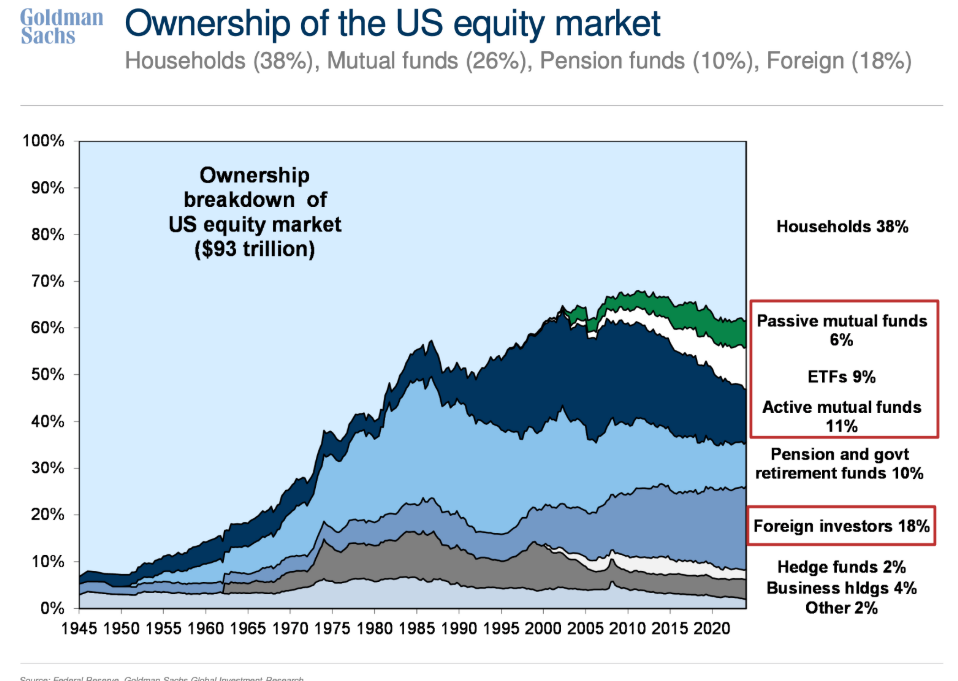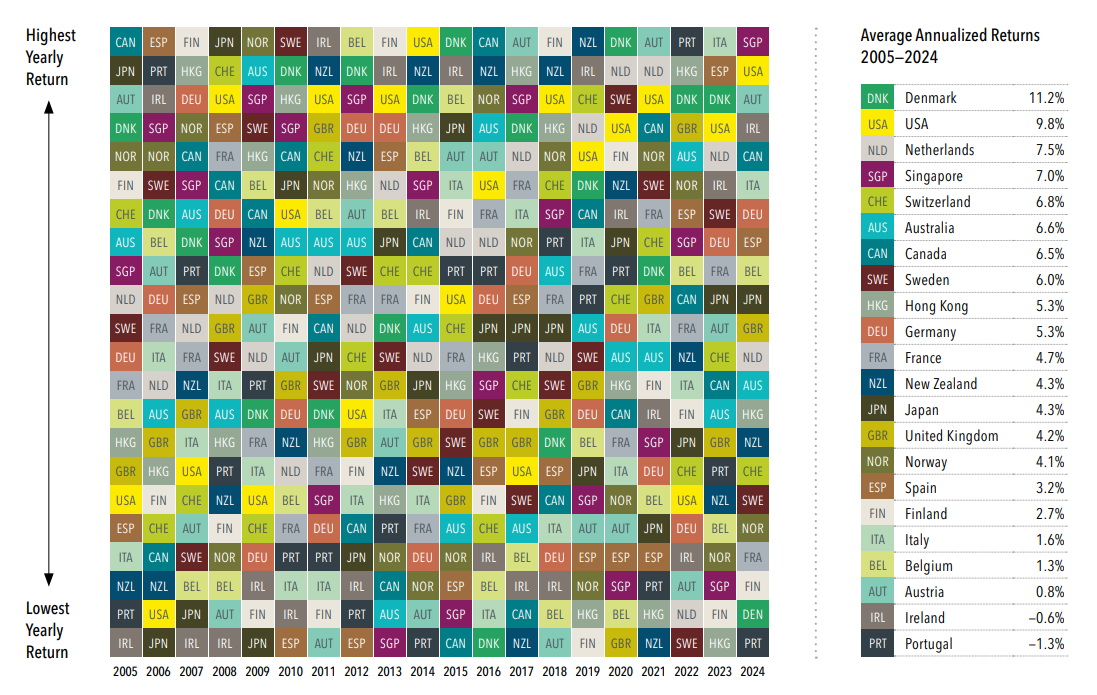CDs and Money Markets I am a little older than you, dt, and also don't have much appetite for risk. However, I do want to beat inflation and aim to have my portfolio earn an annual total return of around 5-7%.
Currently, about 25% of my portfolio is invested in CDs from large national banks, and if they go under then the FDIC will not be of much help anyway. About 50% is in bond funds like CBLDX, ICMUX, RCTIX, etc., and the remaining 25% is in a MM fund for the time being.
Once the Trump tariff induced market turbulence subsides, my thoughts are to invest the MM funds in low SD alternative funds such as QDSNX, QQMNX, etc., and perhaps a balanced fund like PRCFX. But, for this segment of my portfolio I will always be dancing near the exit.
Good luck.
The Week in Charts | Charlie Bilello The Week in Charts (03/24/25) The ultimate guide to home price appreciation, include:
00:00 Intro
00:13 Home Equity as a % of Household Net Worth
00:
50 Historical Data and Booms/Busts
08:24 The Affordability Crisis
10:
59 Recency Bias = High Expectations
16:30 How Much Appreciation Should You Expect?
18:47 Free Wealth Path Analysis
VideoBlog
Fidelity, Schwab Block Orders of BlackRock and Texas Capital ETFs Fidelity does not seem to have updated its documentation with respect to Fidelity Wealth Management.
https://www.fidelity.com/wealth-management/wealth-management-detail
Fidelity® Wealth Services (FWS) Wealth Management service-level clients must generally qualify for support from a dedicated Fidelity advisor ... Account investment minimum is $50,000 for FWS. For details, please review the Program Fundamentals available online or through a representative.
Not the easiest doc to find. The Programs Fundamentals doc that is online is dated March 28, 2024:
Money Market Funds. Cash balances in a Program Account will be invested in the core Fidelity money market fund, the cash sweep vehicle for a Program Account.
https://www.fidelity.com/bin-public/060_www_fidelity_com/documents/FWS-program-fundamentals.pdf
EXTREMELY late TRP tax documents just arrived, 21st March.
Shorting Tesla Maybe rono isn't the only one shorting TSLA....
https://www.thedailybeast.com/multiple-bombs-found-at-tesla-showroom-in-north-austin-texas/Multiple Bombs Found at Tesla Showroom in Texas
SCARY
Nandika Chatterjee
Published 03.24.2
5 2:28PM EDT
The Austin Police Department found “incendiary devices” at a Tesla dealership in North Austin on Monday, Fox 7 reported. Officials responded to a call at about 8:04 a.m. local time in relation to the suspicious devices at the Austin Tesla dealership. On arrival, the police called in the APD Bomb Squad to investigate the devices that were later identified as designed to cause fires. The security incident follows backlash faced by the Elon Musk-owned electric vehicle company. Those opposed to the Department of Government Efficiency (DOGE) boss’ work alongside President Donald Trump seem to have succumbed to targeting Telsa cars and property across the nation. The Austin incident follows a case in which five Tesla vehicles were scorched at a Tesla Collision Center in Las Vegas.
EXTREMELY late TRP tax documents just arrived, 21st March. I've had to mail a bunch of 'sensitive' documents around the country recently. I setup an account with pirateship.com and am using UPS envelopes to send them. For $10 I can overnight to NYC. For $20 I can 2-day something to the west coast. (It'd be $50 going to their store or Staples)
Based on their own track record of deteriorating service in recent years, I don't trust USPS anymore for anything important.
Shorting Tesla
be careful.
both momentum traders and musk fanboys looking to buy dips, and market will over-react to any tariffs delays\cancellations. actual tax cuts would do the same.
one experienced short seller stated look for a point where hardcore fans are so underwater, they will not add or return.
this may be somewhere near intrinsic value, which surveys ~ $30-$50 range. or calc your own.
Fido’s “basket” option Not quite ready for prime time! - A good description of Fido’s basket system based on early impressions. Today I increased the CEF basket holdings from 7 to 9. Each has a weighting of around 11% inside the basket. (As a group they represent 17.5% of portfolio.)
The process:
- First, I put through a single sale from the existing basket of 7 in the necessary dollar sum to fund 2 more equal weight CEFs. This worked like a breeze. The system sold roughly equal sums from each of the 7 and the cash was immediately available for investment inside the Roth..
- Using the proceeds from the sale, I purchased the 2 new CEFs in identical cash amounts. They appeared first in the Roth account listing..
- However, transferring the 2 new CEFs into the existing “basket” was difficult at first. The system required a “percentage” of some sort - but it didn’t say “of what”? You’d think that would be 100% of each of the new CEFs … No!
- I then imputed a % slightly above that of the present basket occupants. That went through and 100% of each of the new funds moved into the basket.
- At first there appears no way to observe the share totals for the various basket occupants all at once. Early on I resorted to clicking on each individual CEF to view shares held - a slow process. However, on the third or fourth day I discovered a link on the main portfolio page that allows you to switch back and forth to either view all holdings with share totals, etc. or simply view the non-basket holdings. It’s hard to spot - “Hidden in plain sight” as they say. :)
- In the end, everything worked. It will be a great feature provided I simply add to, withdraw from or rebalance the entire collection. All that can be accomplished in 1 easy step. However, as I’ve noted - buying a new position or selling an old one could prove trying.
EXTREMELY late TRP tax documents just arrived, 21st March. I was recently notified by USPS Informed Delivery that a letter from TRP will be delivered. ... I did not receive the said letter... Two days later my neighbor brought over the TRP letter.
...
I would trust USPS over TRP for service reliability.
Let me see if I've got this right. USPS failed to deliver a letter to you. If not for the good graces of a neighbor, you never would have known what happened to the letter, let alone recovered it. And you are willing to place any measure of trust in the USPS?
I've watched the USPS lose certified letters that I've sent; leave bags of mail destined for various addresses in the middle of our lobby for hours (as though we were some sort of substation); lose packages that it claimed it delivered to me.
Whatever happened to the 31st JANUARY deadline???
Until this year [2009], the deadline for sending Form 1099-B, Proceeds From Broker and Barter Exchange Transactions, was Jan. 31, the same as for Form W-2 and other information reporting forms. Congress extended the deadline to Feb. 15 in the Emergency Economic Stabilization Act of 2008, which also will require brokers to report the cost basis of securities sold, effective in phases starting in 2011.
https://www.journalofaccountancy.com/news/2009/feb/late1099bmailings/More generally, IRS deadlines (unless the financial institution requests an extension) are here:
https://www.irs.gov/instructions/i1099gi#en_US_2025_publink1000287056Until an institution has the information for an entire account, it will hold off on sending what would be an incomplete combined 1099. For various reasons, some funds are unable to provide complete information quickly and routinely request extensions. For example, in the past PRSVX has distributed some unrecaptured 12
50 gains (box 2b). I suspect that it is because of the possibility of these distributions that TRP delays this fund's tax mailings.
Here's TRP's complete mailing schedule (for investments held directly in mutual fund accounts)
https://www.troweprice.com/personal-investing/resources/planning/tax/preparation/tax-mailing-schedule.htmlThis year, Fidelity delayed sending me a combined 1099 because it was waiting on information from a money market fund, more specifically a Fidelity MMF!
Mid-Year MFO Ratings Posted ... New Navigation Bar Just posted all ratings to
MFO Premium site, using Refinitiv data drop from Friday, 21 March 202
5. Flows remain updated through 14 March.
Bonds Holding Up, But Playbook Is Changing @Observant1, the recent Barron’s article on Ivascyn and Murata’s PIMIX also describes their move to higher quality debts (he likes agency and mortgage-backed bonds) and reduced junk bonds. Additionally, moving from 0.8 to 4.7 years in duration is due ti the flattening yield curve. Here is an excerpt from yogibb,
FUNDS. Ivascyn (and Murata) of multisector giant PONAX / PIMIX are loading up on agency MBS and TIPS but reducing exposure to corporates, nonagency MBS (a Pimco specialty) and HY. Credit spreads are tight, stocks are (still) expensive, so it's focusing on credit quality. The yield-curve is almost flat. He doesn’t expect high inflation or recession and has increased Fund duration a bit. Fund is well positioned for 5-yr timeframe and has a generous distribution. It’s unclear how (or, if) the Administration will calibrate policies with economic data and market signals. (etf cousin is PYLD, riskier CEF cousins are indefinite-term PDI and limited-term PDO, PAXS.) (By @LewisBraham at MFO).
https://www.barrons.com/articles/top-bond-fund-manager-buying-now-2168a117?refsec=funds&mod=topics_funds
The article showed the sector changes over 4 years.
Lipper Names CrossingBridge "Best Fixed Income Small Fund Family Group"
Bonds Holding Up, But Playbook Is Changing Barron's article suggests focusing on high-quality bonds now instead of junk bonds.
The S&P
500 was down more than 8% from its peak on Feb 19 while AGG returned
~1.4% and TLT returned ~3.2% during this period.
"The ICE BofA US High Yield Index Option-Adjusted Spread
jumped to 3.23% Tuesday from 2.68% when the stock market peaked Feb. 19 according to the St. Louis Fed."This has led to losses for junk bond holders but spreads are still narrow on some risky bonds.
The Fed's dot-plot graph suggests two interest-rate cuts this year which could accelerate bond returns.
Growth concerns have now superceded inflation concerns in the Treasury market.
https://www.msn.com/en-us/money/markets/bonds-are-holding-up-but-the-playbook-is-changing/ar-AA1BfTXl
Fido’s “basket” option Fidelity allows users to create “baskets” of securities for ease of trading or rebalancing. It’s an interesting concept I spent over an hour exploring today. Clunky / frustrating to say the least. I wanted to see if it was easier to buy and sell from a collection of funds (all my CEFs) instead of having to sell or add to each separately.
- The option allows you to set-up / manage up to 5 portfolios, each with up to 50 securities (stocks, etfs, CEF s, etc.).
- There’s a $4.99 monthly fee for the service (after one free month)
- You can cancel at any time. If you do, the holdings will revert back into your regular account.
- When you move holdings into a designated basket they no longer appear under your main account. In my case about half my Roth IRA holdings disappeared from the Roth account. There’s a “basket” link nearby, however, so you can easily access the basket holdings.
- Settings allow you to set the “weight” of each holding or simply input “equal weight.”
- Apparently to rebalance back to your set allocations you simply press a tab and the program executes the necessary buys and sells. I’ll better understand that feature as the trading week ensues.
- Disappointingly, once you have moved existing holdings into a basket, share totals fail to appear (dollar values and other data do surface). This might possibly clear up with time? It’s still possible, however, to view total shares by clicking on a specific holding inside the basket.
If anyone uses this feature and / or has additional insights into the technicalities involved please share.
Ownership breakdown of US equity market & Return by Country A Wealth of Common Sense detailed some interesting charts....
https://awealthofcommonsense.com/2025/03/the-stock-market-is-always-changing/Per Goldman Sachs, ownership of US equities:
38% Households
18% Foreign investors
11% Active mutual fund
6% passive mutual fund
9% ETFs
10% Pension/govt retirement
4% Business holdings
2% Hedge Funds

And
Denmark is champion of the past 20 year returns (market return by country), followed by the USA...


